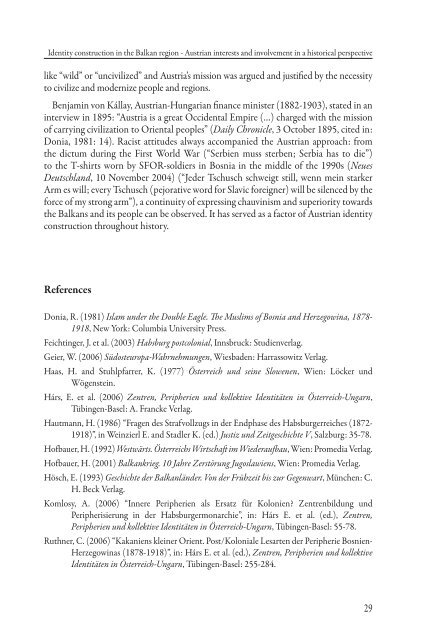free download in pdf format - Culturelink Network
free download in pdf format - Culturelink Network
free download in pdf format - Culturelink Network
You also want an ePaper? Increase the reach of your titles
YUMPU automatically turns print PDFs into web optimized ePapers that Google loves.
Identity construction <strong>in</strong> the Balkan region - Austrian <strong>in</strong>terests and <strong>in</strong>volvement <strong>in</strong> a historical perspective<br />
like “wild” or “uncivilized” and Austria’s mission was argued and justifi ed by the necessity<br />
to civilize and modernize people and regions.<br />
Benjam<strong>in</strong> von Kállay, Austrian-Hungarian fi nance m<strong>in</strong>ister (1882-1903), stated <strong>in</strong> an<br />
<strong>in</strong>terview <strong>in</strong> 1895: “Austria is a great Occidental Empire (…) charged with the mission<br />
of carry<strong>in</strong>g civilization to Oriental peoples” (Daily Chronicle, 3 October 1895, cited <strong>in</strong>:<br />
Donia, 1981: 14). Racist attitudes always accompanied the Austrian approach: from<br />
the dictum dur<strong>in</strong>g the First World War (“Serbien muss sterben; Serbia has to die”)<br />
to the T-shirts worn by SFOR-soldiers <strong>in</strong> Bosnia <strong>in</strong> the middle of the 1990s (Neues<br />
Deutschland, 10 November 2004) (“Jeder Tschusch schweigt still, wenn me<strong>in</strong> starker<br />
Arm es will; every Tschusch (pejorative word for Slavic foreigner) will be silenced by the<br />
force of my strong arm”), a cont<strong>in</strong>uity of express<strong>in</strong>g chauv<strong>in</strong>ism and superiority towards<br />
the Balkans and its people can be observed. It has served as a factor of Austrian identity<br />
construction throughout history.<br />
References<br />
Donia, R. (1981) Islam under the Double Eagle. Th e Muslims of Bosnia and Herzegow<strong>in</strong>a, 1878-<br />
1918, New York: Columbia University Press.<br />
Feicht<strong>in</strong>ger, J. et al. (2003) Habsburg postcolonial, Innsbruck: Studienverlag.<br />
Geier, W. (2006) Südosteuropa-Wahrnehmungen, Wiesbaden: Harrassowitz Verlag.<br />
Haas, H. and Stuhlpfarrer, K. (1977) Österreich und se<strong>in</strong>e Slowenen, Wien: Löcker und<br />
Wögenste<strong>in</strong>.<br />
Hárs, E. et al. (2006) Zentren, Peripherien und kollektive Identitäten <strong>in</strong> Österreich-Ungarn,<br />
Tüb<strong>in</strong>gen-Basel: A. Francke Verlag.<br />
Hautmann, H. (1986) “Fragen des Strafvollzugs <strong>in</strong> der Endphase des Habsburgerreiches (1872-<br />
1918)”, <strong>in</strong> We<strong>in</strong>zierl E. and Stadler K. (ed.) Justiz und Zeitgeschichte V, Salzburg: 35-78.<br />
Hofb auer, H. (1992) Westwärts. Österreichs Wirtschaft im Wiederaufb au, Wien: Promedia Verlag.<br />
Hofb auer, H. (2001) Balkankrieg. 10 Jahre Zerstörung Jugoslawiens, Wien: Promedia Verlag.<br />
Hösch, E. (1993) Geschichte der Balkanländer. Von der Frühzeit bis zur Gegenwart, München: C.<br />
H. Beck Verlag.<br />
Komlosy, A. (2006) “Innere Peripherien als Ersatz für Kolonien? Zentrenbildung und<br />
Peripherisierung <strong>in</strong> der Habsburgermonarchie”, <strong>in</strong>: Hárs E. et al. (ed.), Zentren,<br />
Peripherien und kollektive Identitäten <strong>in</strong> Österreich-Ungarn, Tüb<strong>in</strong>gen-Basel: 55-78.<br />
Ruthner, C. (2006) “Kakaniens kle<strong>in</strong>er Orient. Post/Koloniale Lesarten der Peripherie Bosnien-<br />
Herzegow<strong>in</strong>as (1878-1918)”, <strong>in</strong>: Hárs E. et al. (ed.), Zentren, Peripherien und kollektive<br />
Identitäten <strong>in</strong> Österreich-Ungarn, Tüb<strong>in</strong>gen-Basel: 255-284.<br />
29



